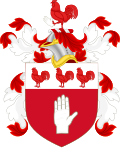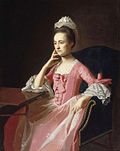John Hancock

John Hancock (January 12, 1737 – October 8, 1793)[1] was an early American patriot, a leader in the American Revolutionary War, and an American statesman. He was the first man to sign America's Declaration of Independence. Today in the United States, "John Hancock" is a synonym for signature.[2]
Hancock's ancestors arrived in the English colonies in 1652. In 1737, Hancock was born in Braintree (now Quincy, Massachusetts).[1] When his father died, he was adopted by his uncle, a merchant in Boston, Massachusetts. At his uncle's death in 1754, Hancock inherited the business. He became a leading merchant in Boston[2] and one of the richest in the colonies.
In 1768, British officials seized Hancock's ship, the Liberty, and accused him of smuggling. The Liberty was carrying a shipment of wine at the time. Patriots in Boston rioted, and Hancock was acquitted. This was one of the events that led to the American Revolutionary War.[2]
Hancock had several important jobs in Colonial America and the early United States of America. He was president of the Massachusetts Provincial Congress in 1774 and 1775. He used his money to support American independence. The British thought him a very dangerous man.[2]
Hancock was president of the Continental Congress in 1774 and 1775. He wanted to lead the Continental Army, but George Washington got the job instead.[2][1] With 5,000 troops, he tried to free Rhode Island from the British, but was not successful.[2]
Hancock led the convention that adopted the Massachusetts Constitution in 1780.[2] He was the first Governor of Massachusetts,[2] and served nine terms.
In his later life, Hancock suffered from gout.[1] He died in 1793.[2]
John Hancock Media
Around 1772, Hancock commissioned John Singleton Copley to paint this portrait of Samuel Adams, Hancock's early political mentor.[3]
c. 1765 portrait of Hancock by John Singleton Copley
This portrait of Hancock was published in England in 1775. Troops [4]
This March 24, 1775, resolution in the Massachusetts Provincial Congress of which Hancock was president, resolves that measures for "putting this colony into a complete state of defense, be still most vigorously pursued by the several towns, as well as individual inhabitants".
Wary of returning to Boston, Hancock was staying at the Hancock–Clarke House in Lexington when the Revolutionary War began. This house was built by Hancock's grandfather. John Hancock lived there as a boy.[5]
Hancock's wife Dorothy Quincy, by John Singleton Copley, c. 1772
References
- ↑ 1.0 1.1 1.2 1.3 "John Hancock". Encyclopædia Britannica Online. Retrieved 27 February 2011.
- ↑ 2.0 2.1 2.2 2.3 2.4 2.5 2.6 2.7 2.8 World Book Encyclopedia. 2012. Volume 9. Scott, Foresman. pp. 38-39.
- ↑ Fowler 1980, p. 153.
- ↑ Fowler 1980, p. following 176.
- ↑ Fischer 1994, pp. 94, 108.








